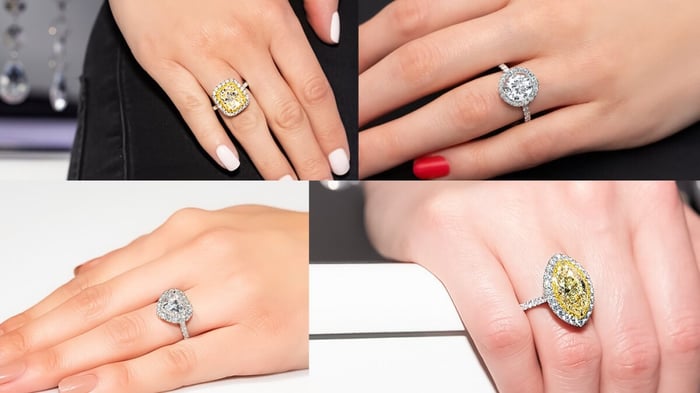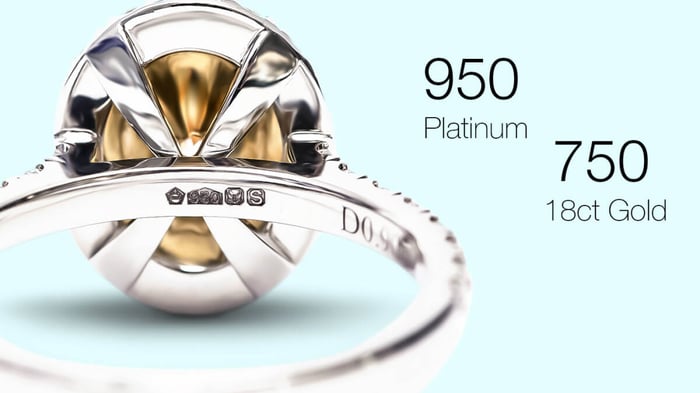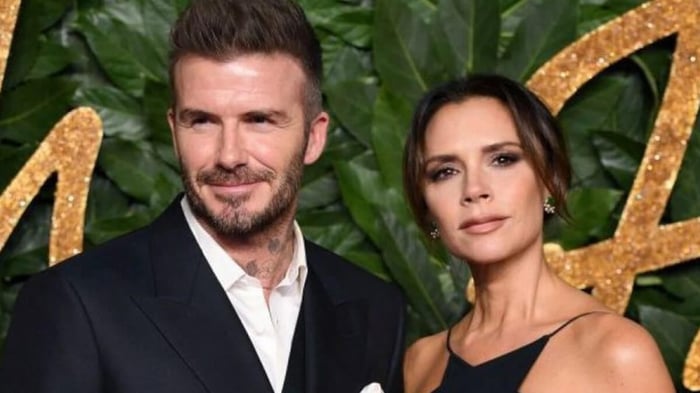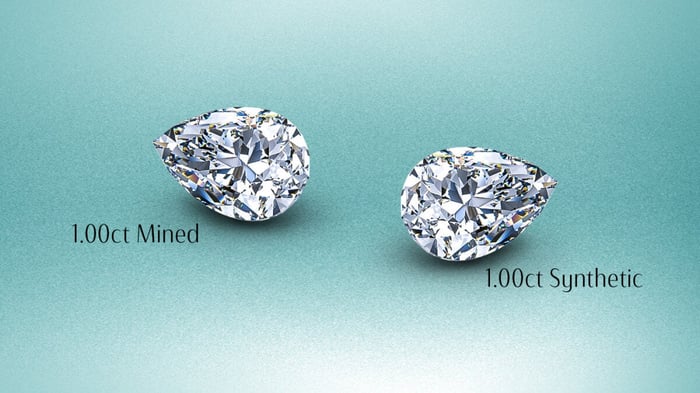What Are The Most Popular Shapes Of Diamond?
When almost anyone thinks about diamonds, there is one shape (or cut) the springs to mind, the first thought is of the classic round shape, tapered to its base. There are another nine classic shapes for diamonds used in jewellery at All Diamond. The article below describes the most popular diamond shapes used in modern diamond jewellery.
1 - Round Cut Diamonds

The round diamond shape (cut) is absolutely the most popular cut for diamonds today. Sometimes this cut is referred to as the Tolkowsky Ideal Cut or the American Ideal Cut. Devised initially in Europe by Cardinal Mazarin in 1650 and developed to the current form in 1919 by Marcel Tolkowsky, a Russian mathematician and diamond maven. This is the cut that maximises the shine of the diamond by following the lines of the rough diamond crystal.
Today’s round diamond has 58 facets that have been calculated to maximise the brilliance of any rough (uncut) diamond.
Over half of all diamonds sold feature the round cut.
When buying this shape of diamond buy the highest quality grades within your budget to get the best of the brilliance that this shape can provide.
2 - Princess Cut Diamonds
The Princess Cut is a square or rectangular-shaped diamond second only to the Round Cut diamond shape for its brilliance. Owners of Princess cut diamonds treasure the unique way in which the stone’s colour is displayed. Most diamonds show their colour in the centre, but the Princess Cut shows colour in each of the corners.
The Princess Cut is a square (rectangular) version of the classic Round Cut. The contemporary version of the cut was devised in 1979 by Betzalel Ambar, Israel Itzkowitz, and Ygal Perlman as a development of earlier shapes such as the Profile Cut, Quadrillion, and Barion Cut.

Modern Princess Cut stones have 58 facets made similarly to the Round Cut diamond.
The many facets of a Princess Cut stone allow a lot of light to pass through the stone, this serves to conceal inclusions. The square shape makes it an excellent choice for rings with multiple stones because they can be set side by side without gaps.
The modern Princess Cut is patented, and so the shape is often shown on gemological laboratory certificates by the technical names: Square Modified Brilliant or Rectangular Modified Brilliant.
3 – Cushion Cut Diamonds
Following next in popularity is the Cushion Cut, sometimes referred to as Pillow Cut. The name is descriptive of the shape. The shape is similar to the Princess Cut but with rounded corners and larger facets. The original name for this shape was Mine Cut and was developed in the 19th century.

The large facets give a very brilliant appearance and can be cut to a relatively square, or rectangular shape. Modern Cushion Cut stones have 64 facets, but older Cushion Cut diamonds will usually have just 58. Some jewellers offer modified versions of this diamond shape with moon-shaped facets or an extra row of facets giving a slightly unusual appearance compared to the standard Cushion Cut.
4 - Emerald Cut Diamonds
Emerald Cut diamonds are named after the eight-sided shape commonly used when cutting emeralds. The overall shape is rectangular, or sometimes square, with the corners truncated to reduce the possibility of damage to the stone. Emerald cut shows off the clarity of the gem due to the large flat top to the stone. The flat top enhances any colour in the diamond but also makes inclusions more obvious.
Emerald Cut diamonds usually have 57 facets but may have more if the number of rows of facets is increased.
The modern Emerald Cut can trace its roots back to the 16th century with today’s version becoming popular during the Art Deco period of the early part of the 20th century.
5 - Asscher Cut Diamonds
Asscher Cut stones, sometimes referred to as Square Emerald Cut, have eight sides like the Emerald Cut. The Asscher Cut was devised in 1902 and was patented by the creator, Joseph Asscher. This was the first diamond cut to be patented. Although the Asscher Cut is similar to the Emerald Cut, Ascher Cut stones have larger facets at the side with a smaller crown and smaller top. The effect is to give a weightier visual appearance.

More recently, in 1999, the Royal Asscher Diamond Company devised an improved variant called the Royal Asscher Cut increasing the number of facets to 74.
6 - Marquise Cut Diamonds
Marquise Cut diamonds have a long, boat style shape, an oval with pointed ends. Buyers like this shape of stone because it looks large for its carat weight. This cut was first created in Paris in the mid-18th century. The story goes that King Louis 15th wanted a diamond to match the smile of his mistress. During the 20th century, the shape has been refined such that it is now an extended version of the classic Round Cut with 58 facets.

This is a shape that flatters shorter fingers, making them appear longer and more slender.
When buying a Marquise Cut diamond, it is essential to make sure that the stone is fully symmetrical about its length so that it looks straight when mounted into a ring or pendant.
Brazalete de diamantes redondos y talla baguette Diamante G/SI de 1,85 quilates en oro blanco de 18 k

€4.438,95
Esta pulsera esclava moderna y de moda es una opción fácil de usar que se puede usar sola o apilada con otras joyas. Esta pieza llamativa combina con todo, lo que la convierte en la favorita para cualquier ocasión. Esta… read more
7 – Radiant Cut Diamonds
The Radiant Cut diamond shape was invented by the jeweller Henry Grossbard in 1976. The Radiant Cut combines elements of Round, Emerald, and Princess cuts. Because of this combination of the best of each the cut is becoming very popular in modern jewellery. Because the cut is patented, gemological reports often refer to the stone as a Cut-Cornered Square which describes the shape very well.
The primary benefit of this cut is that it is more brilliant than other square shapes. The effect is achieved by using the same type of cutting as a Round Cut stone, but with 74 facets, with a conical base that channels light upward through the stone.

Due to the brilliance of the Radiant Cut, buyers can get away with slightly more inclusions than on other square cuts such as Asscher and Emerald.
8 – Oval Cut Diamonds
Oval shaped diamonds were first cut in the 18th century, but the form seen in modern jewellery was designed in the 1960s by a Russian diamond cutter, Lazare Kaplan. The Oval is a compromise in shape between Pear and Round cuts. This is another cut that can make a stone look larger than it really is and, like the Marquise, can serve to make the wearer’s fingers look longer and more slender.
Marquise Cut stones are typically cut to 58 facets.

Perhaps because of their perceived good value, and certainly, because they are easily matched with other jewellery, Oval Cut diamonds have become very popular in engagement rings.
9 – Pear Cut Diamonds
Pear Cut stones are a blend of both Marquise and Round shapes with one round end and the other coming to a point. As with the Marquise, the Pear Cut tends to flatter the wearer's fingers, making them appear longer.
Sometimes, Pear Cut stones are called Teardrop or Pendeloque Cut. The Pear Cut was developed in the 15th century by a Flemish diamond cutter named Lodewyk Van Berquem. He was also the inventor of the diamond polishing wheel that made it possible for diamonds to be used in jewellery.
Modern Pear Cut stones are cut using 56 or 58 facets.
10 – Heart Cut Diamonds
The exact date of the introduction of the Heart Cut is unknown; however, paintings from the 17th century depict Heart shaped diamonds. As with the Pear Cut, there are usually 56 or 58 facets to the diamond.
This cut is a favourite because of its direct symbolism; because of its shape, it works well in both pendants and rings.
When buying a Heart shaped diamond, it is important not to buy too small because smaller stones, less than 0.5 carats can look round when mounted. Check the stone for perfect symmetry so that both sides of the Heart look identical.

Although these are the most popular diamond shapes, there are others available. Antique pieces may have diamonds that have shapes that do not match with modern diamond shapes because shapes have changed as diamond cutting techniques have improved, making modern diamonds more brilliant, more beautiful, than ever before.




